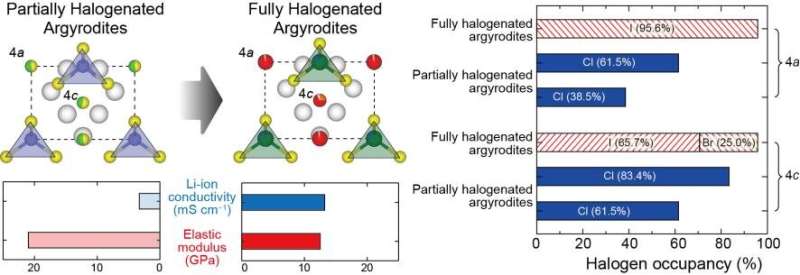Summary of new technology to control ionic conductivity and elastic modulus by forming fully halogenated argyrodites. By controlling the halogenation rate, a solid electrolyte was synthesized for all-solid-state batteries was synthesized; this electrolyte maximizes ionic conductivity while having a low elastic modulus. Credit: Korea Institute of Science and Technology
The all-solid-state battery is a secondary battery with a solid electrolyte between the anode and cathode. It is considered a representative of next-generation battery technology due to its high energy density and significantly lower risk of fire and explosion than conventional lithium-ion batteries.
In recent years, materials research in the field of all-solid-state batteries has been focused on strategies to maximize material crystallinity to achieve ionic conductivity similar to that of liquid electrolytes (ionic conductivity of 10 mS/cm or more). However, this approach requires a high-temperature crystallization step (above 500 °C) of up to several days after material mixing or reaction. It resulted in high process costs and battery interface contact issues due to reduced mechanical deformability.
Dr. Hyoungchul Kim's research team at the Energy Materials Research Center, Korea Institute of Science and Technology (KIST), announced that they have successfully synthesized a solid electrolyte with superionic conductivity and high elastic deformability in a one-pot process at room temperature and normal pressure. This research has garnered attention because it can maximize the productivity of all-solid-state battery materials and solve the inherent interface problem by improving elastic deformation. The study is published in the journal Advanced Functional Materials.
Dr. Kim's research team focused on the crystallographic features of the argyrodite sulfides to synthesize a highly deformable and ionically conductive solid-state electrolyte material under normal temperature and pressure conditions. Theoretically, ionic conductivity can be maximized by maximizing the halogen substitution rate at the 4a and 4c sites in the argyrodite crystal, but the material has never been practically synthesized due to its thermodynamic instability. In addition, typical crystalline argyrodite superconductors require high-temperature heat treatment above 500 °C.
Therefore, the halogen substitution rate cannot be maximized, and the elastic modulus decreases with increasing crystallinity, leading to rapid degradation of cell performance. In contrast, without high-temperature heat treatment, a low elastic modulus similar to that of glass can be obtained; however, the ionic conductivity remains around 3 mS/cm, limiting its applicability as a solid-state electrolyte.
Summary of results for crystallinity, ionic conductivity, and daily process progress for electrolytes synthesized by the two-step mechanochemical milling method. The new solid electrolyte developed by the room-temperature one-pot process has high crystallinity (~57.39%) and ionic conductivity (~13.23 mS/cm) without any high-temperature heat treatment process. Moreover, this research has afforded the highest productivity among the reported methods for the synthesis of superconductive solid electrolyte materials. Credit: Korea Institute of Science and Technology
The research team came up with a new strategy to obtain a thermodynamically unstable structure (i.e., fully halogenated argyrodite) that takes advantage of both crystalline and glassy properties. They developed a composition control method to lower the crystallization temperature of argyrodite as well as a new two-step mechanochemical milling process suitable for the lower crystallization temperature. This facilitated the synthesis of a fully halogen-substituted (~90.67% substitution) argyrodite with a superionic conductivity of ~13.23 mS/cm without a long high-temperature annealing.
The synthesized material also possesses an elastic modulus of about 12.51 GPa, which is one of the lowest reported values for superionic-conductive solid electrolytes, and this is also advantageous for improving the interfacial performance of all-solid-state batteries. Moreover, the new one-pot process at room temperature and normal pressure can be completed in less than 15 h, which is the highest productivity for any solid electrolyte with superionic conductivity. This is a unique achievement, with material productivity that is approximately 2–6 times higher than those of conventional processes for synthesizing superconductive solid electrolytes.
"We have succeeded in developing a new solid electrolyte material with high deformability and ionic conductivity through a new process at normal temperature and pressure," said Dr. Kim of KIST, who led the research. He also expressed his expectation, saying, "The new material will serve as a trigger for the commercialization of all-solid-state batteries suitable for electric vehicles and energy storage systems (ESS) because it has maximized material productivity by eliminating the high-temperature heat treatment and simultaneously possesses high deformability and superionic conductivity suitable for solving the problem of the electrode interface of all-solid-state batteries."
More information: Wo Dum Jung et al, Annealing‐Free Thioantimonate Argyrodites with High Li‐Ion Conductivity and Low Elastic Modulus, Advanced Functional Materials (2022). DOI: 10.1002/adfm.202211185
Journal information: Advanced Functional Materials
Provided by National Research Council of Science & Technology

























